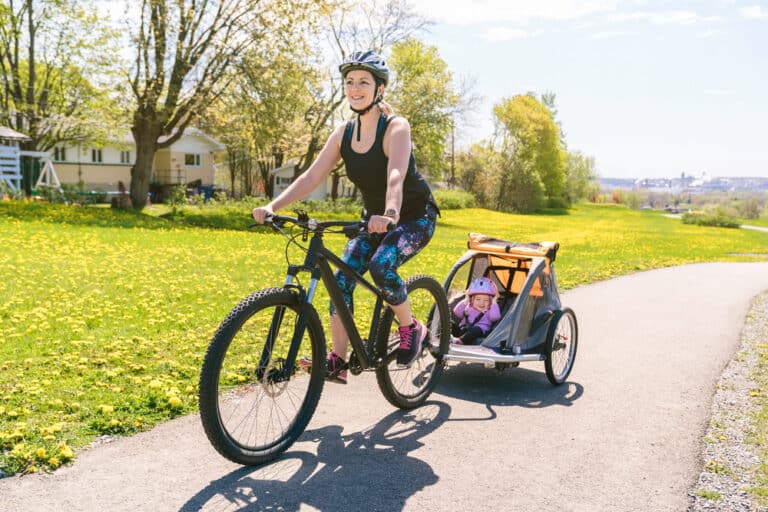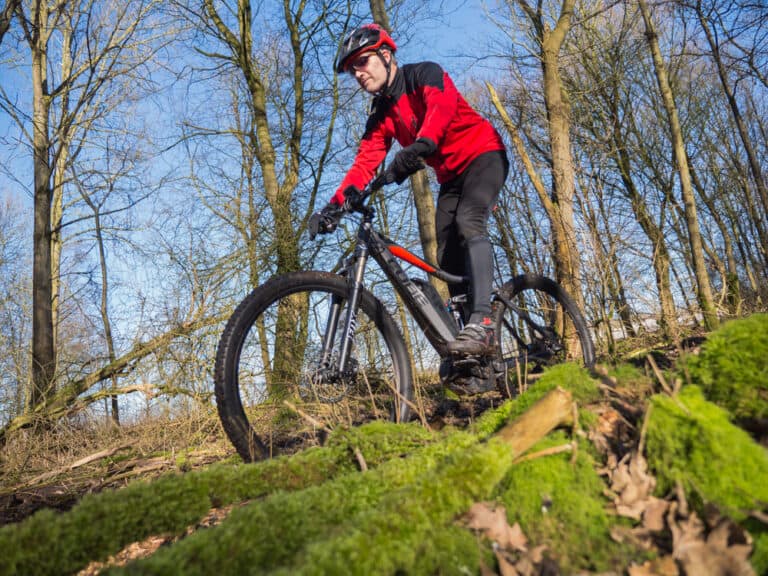Can You Ride A Bike With A Broken Spoke?

The first bicycle wheels followed the design principles of the old wagon wheels; however, instead of wooden wheel rims and spokes, high-strength steel was used. Over time the steel was changed to an aluminum alloy which increased the strength and helped resist rust and corrosion.
You can ride a bike when a spoke is broken, and as long as the damage remains limited to one or two spokes on the whole wheel, it is perfectly safe to continue your ride. However, if more spokes break, or the breaks start to cascade you must find the reason and rectify the problem.
Bicycle spokes keep the wheel supported and in correct alignment with the hub. If only a few spokes start to break, considerable redundancy is built in, and the bicycle will remain useable until you can fix the problem.
You Can Ride A Bike With A Broken Spoke
You can continue riding your bike if you break a spoke while out on a ride or even for a short time afterward while waiting for a replacement to be delivered.
However, if more than one or two spokes break, the integrity of the bicycle wheel will be compromised, and it should be rectified as soon as possible.
It doesn’t mean that a broken spoke or two should be left and the bicycle is continually ridden for a long term.
Unfortunately, a broken spoke sometimes leads to a cascade of broken spokes. The wheel’s strength at the damaged portion is weakened, and the remaining spokes have to carry the extra load.
If the spoke bends, it may get caught up in parts of the bicycle frame or cog.
Spokes breaking on the front wheel add a more immediate danger, not only because of possible stability issues, but if it collapses, the rider will go head over heels, with possible injuries being caused.
It contrasts with the back wheel, where if it collapses, the bicycle falls, but there is less potential for the rider to be insured during the event.
What Are Spokes, And What Purpose Do They Serve?
Spokes are the thin metal (aluminum composite) rods that connect the outer rim to the bicycle’s wheel hub. Most traditional bike wheels have 28, 32, or 36 spokes.
The higher the number of spokes installed, the lower the forces imposed on each spoke and, therefore, the stronger the wheel; however, it also means it is heavier.
On equipment such as mountain bikes where weight is not as big an influence, there will generally be more, and they will tend to be straight.
Spokes are interlinked in a 3‐cross or 3X lacing pattern, which means that a spoke crosses 3 other spokes as it connects to the hub. The 3‐cross lacing pattern increases the load-bearing ability and makes them more durable. Bicycles, such as mountain bikes requiring greater strength, may have spokes interlaces with a 4 5- cross lacing.
Spokes on a bicycle wheel are an ingenious design where they have three functions.
- The spokes add strength to the bicycle wheels rim.
- The spokes keep the rum in the correct orientation to the wheel’s hub.
- The spokes on both wheels also play an obvious role in supporting the cyclist’s weight.
- The spokes on the rear wheel convert the rotational force which the cyclist applies to the pedals, crank, chain, and sprockets, to the rim of the wheel and tire, against the road surface, which provides the motive force to move forwards.
They provide these functions while being lightweight, low cost, and having minimal downsides.
The alternative to spokes would be carbon fiber discs; however, there are three issues with these.
- If the rider is traveling in a strong crosswind, the wheels act like sails, making the bicycle very difficult to control.
- They are very expensive.
- Wheels with discs instead of spokes lack the malleability of spoked wheels, causing them to have a harsher ride over rough surfaces.
Are All Spokes The Same?
There are three types of spokes.
- Straight Gauge Spokes.
- Swaged Spokes.
- Bladed Spokes.
The Straight Gauge Spokes
These are the simplest and most commonly used spoke.
As the name suggests, straight gauge spokes are the same diameter for the whole length between the wheel rim and the hub.
While still saving weight, the traditional straight gauge spokes are the heaviest and least durable of each spoke type.
Swaged Spokes
Double‐butted or butted spokes are two different types of spoke.
- Double butted spokes are thinner in the middle and thicker at each end
- Butted spokes are thicker in the middle and narrower at each end
Both swaged spokes are created by drawing a traditional spoke through a reducing die.
Changing the diameter (thickness) of a straight gauge spoke increases elasticity, adding strength while reducing the weight of a conventional straight gauge spoke.
Swaged spokes also transfer the vibrations at the outer tips and absorb them in the mid-section, which translates into a better, more responsive riding experience.
Bladed Spokes
Bladed spokes (sometimes referred to as Aero Spokes) are straight spokes that have undergone two additional manufacturing processes.
- Firstly, the straight spokes are drawn through a die and become Swaged spokes.
- The next stage is that they are flattened and so become blade spokes.
Bladed spokes are stronger and can better resist twisting forces than straight spokes.
Bladed spokes are more aerodynamically efficient than the other types of spokes and are often used on short course racing bikes, called aero bikes.

Why Do Bicycle Spokes Break?
There are several reasons why spokes break, and the main causes are the following.
Too Much Weight
If the bicycle carries too much weight, the spokes will be stressed.
It is not just the weight of the rider but rather the g-forces that the spokes are subject to. For example, landing in a ditch on the front wheel places much more force on the front wheel spokes than traveling on a level road.
The Metal Spokes Have Become Fatigued
If the bicycle has been used in hard conditions while carrying heavy loads, particularly if it has been ridden on the coast, the spikes may fail.
The Bicycle Wheel Rim Is Damaged
If the wheel has been damaged by frontal collisions (hitting a pothole) or is damaged to the side, the spokes will have additional loads placed on them, which can cause them to fail.
Mechanical Equipment Fails
Sometimes mechanical equipment fails, and it is hard to trace the actual cause.
It is also true of spokes, where one or two break for no discernable reason – possibly due to old age and wear.
Conclusion
You can continue to ride a bicycle with a broken spoke; however, if more spokes start to break, the cause must be investigated and fixed to prevent it from happening again. The problem may be an isolated incident; however, if the rim is bent or there is some other reason, this could cause a cascade of spokes.







